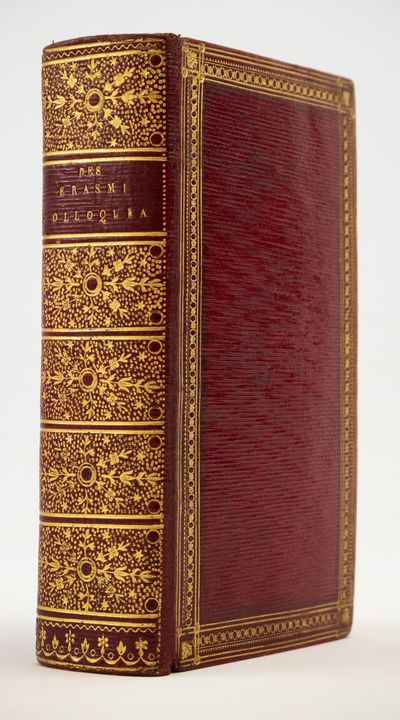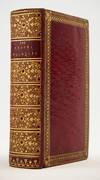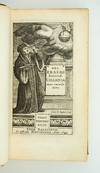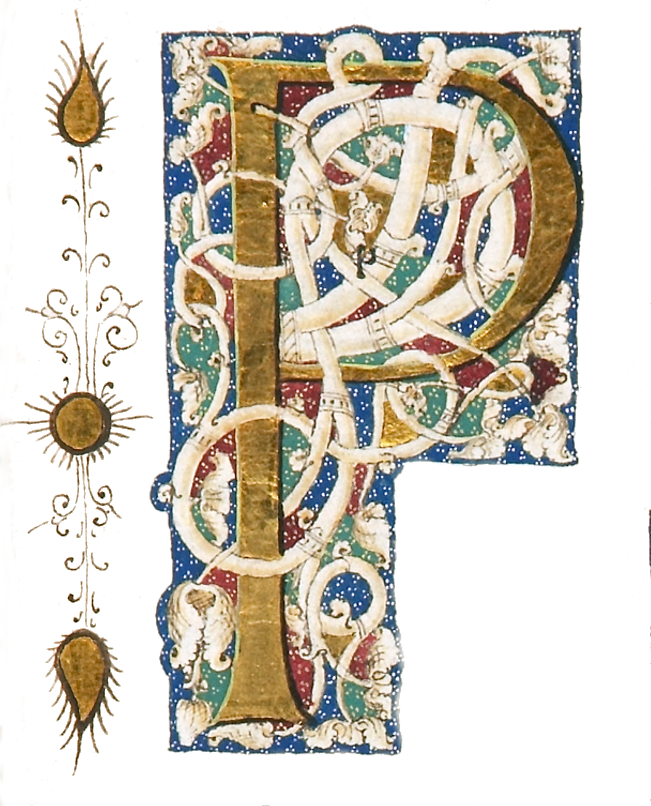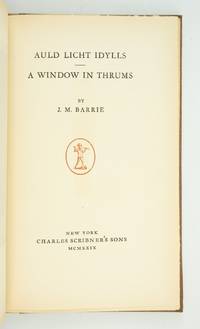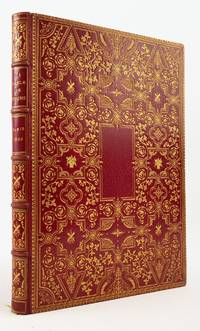1643 · Lugduni Batavorum [Leyden]
by (BINDINGS - BOZERIAN). (ELZEVIER IMPRINT). ERASMUS, DESIDERIUS
Lugduni Batavorum [Leyden]: Bonaventura Elzevier and Abraham Elzevier, 1643. Second Elzevier Edition. 137 x 78 mm. (5 1/2 x 3"). 12 p.l., 672, 44 pp., [2] leaves.
ELEGANT EARLY 19TH CENTURY RED STRAIGHT-GRAIN MOROCCO, VERY ELABORATELY GILT, BY BOZERIAN (unsigned, but see below), covers framed by bead-and-star roll enclosed with double gilt fillets, leaf tools at corners. smooth spine in compartments with large central fleuron of floral lancets emanating from central circlet in a richly stippled ground, small circles at corners, one compartment with gilt lettering, cresting tulip and violet roll at foot of spine, turn-ins with bead-and-star roll, marbled endpapers, vellum flyleaves, all edges gilt. Woodcut initials, headpieces, and tailpieces, numismatic portrait tondo, fine engraved title page by C. C. Dusend showing Erasmus gazing through a telescope at the Godly orb seen through parted clouds. Willems 552; Rahir 546; USTC 1027918. For the binding: Culot, "Jean Claude Bozerian," Roulette 9 (Plate I) and Palette 12 (Plate X). Just barely perceptible rubbing to joints and extremities, one leaf with tiny burn hole affecting a couple of words, intermittent minor foxing, negligible ink spots here and there, other trivial imperfections, but an extremely attractive copy, the text fresh and clean, and the very well-preserved binding with lustrous leather and bright gilt.
This is a remarkably pretty copy of an extremely influential but generically elusive work, printed by a legendary press and bound by the founder of a celebrated French binding dynasty. First published in 1524, the "Colloquia" comprise 63 conversations originally written for Erasmus' students on varied and overlapping topics, but these urbane meditations soon became widely read, as they covered subjects that intrigued the important thinkers of the day. Their influence was so profound that it is not saying too much to claim that they helped to speed the Reformation. Although they are difficult to classify precisely, one could categorize them as including, in general terms, exposure of ritualistic fallacies, invective against corruption within the church, examination of popular imposture, deploring of contemporary personal sins, practical advice for laymen, and miscellaneous discussion of amusing topics. In specific terms, the text takes on such controversial topics as the value of pilgrimage, celibacy, and abstinence from meat on Fridays and other prescribed days. Erasmus' "Colloquia" was frequently published by the Elzeviers, once in French and a total of nine times in Latin. The text was universally adopted for school use up through the 18th century. Although our lovely little binding is unsigned, Culot firmly identifies its tools as those used by Jean-Claude Bozerian (1762-1840). He was the elder of the Bozerian brothers (François is referred to as "le jeune") and was active in Paris from 1795 to about 1810. He began his career in Lyon as an apprentice bookseller, printer, and bookbinder, eventually deciding to focus on the latter craft. Marriage to the widow of binder Pierre Boulier allowed him to establish a binding workshop in Paris, where he was joined by his brother. His bindings were soon much in demand by French bibliophiles, who appreciated their superior materials, tasteful design, and flawless execution--all characteristics that are plainly evident in the present case.. (Inventory #: ST20492)
ELEGANT EARLY 19TH CENTURY RED STRAIGHT-GRAIN MOROCCO, VERY ELABORATELY GILT, BY BOZERIAN (unsigned, but see below), covers framed by bead-and-star roll enclosed with double gilt fillets, leaf tools at corners. smooth spine in compartments with large central fleuron of floral lancets emanating from central circlet in a richly stippled ground, small circles at corners, one compartment with gilt lettering, cresting tulip and violet roll at foot of spine, turn-ins with bead-and-star roll, marbled endpapers, vellum flyleaves, all edges gilt. Woodcut initials, headpieces, and tailpieces, numismatic portrait tondo, fine engraved title page by C. C. Dusend showing Erasmus gazing through a telescope at the Godly orb seen through parted clouds. Willems 552; Rahir 546; USTC 1027918. For the binding: Culot, "Jean Claude Bozerian," Roulette 9 (Plate I) and Palette 12 (Plate X). Just barely perceptible rubbing to joints and extremities, one leaf with tiny burn hole affecting a couple of words, intermittent minor foxing, negligible ink spots here and there, other trivial imperfections, but an extremely attractive copy, the text fresh and clean, and the very well-preserved binding with lustrous leather and bright gilt.
This is a remarkably pretty copy of an extremely influential but generically elusive work, printed by a legendary press and bound by the founder of a celebrated French binding dynasty. First published in 1524, the "Colloquia" comprise 63 conversations originally written for Erasmus' students on varied and overlapping topics, but these urbane meditations soon became widely read, as they covered subjects that intrigued the important thinkers of the day. Their influence was so profound that it is not saying too much to claim that they helped to speed the Reformation. Although they are difficult to classify precisely, one could categorize them as including, in general terms, exposure of ritualistic fallacies, invective against corruption within the church, examination of popular imposture, deploring of contemporary personal sins, practical advice for laymen, and miscellaneous discussion of amusing topics. In specific terms, the text takes on such controversial topics as the value of pilgrimage, celibacy, and abstinence from meat on Fridays and other prescribed days. Erasmus' "Colloquia" was frequently published by the Elzeviers, once in French and a total of nine times in Latin. The text was universally adopted for school use up through the 18th century. Although our lovely little binding is unsigned, Culot firmly identifies its tools as those used by Jean-Claude Bozerian (1762-1840). He was the elder of the Bozerian brothers (François is referred to as "le jeune") and was active in Paris from 1795 to about 1810. He began his career in Lyon as an apprentice bookseller, printer, and bookbinder, eventually deciding to focus on the latter craft. Marriage to the widow of binder Pierre Boulier allowed him to establish a binding workshop in Paris, where he was joined by his brother. His bindings were soon much in demand by French bibliophiles, who appreciated their superior materials, tasteful design, and flawless execution--all characteristics that are plainly evident in the present case.. (Inventory #: ST20492)
